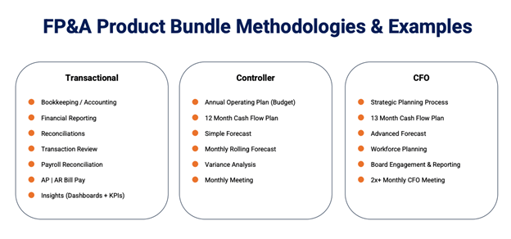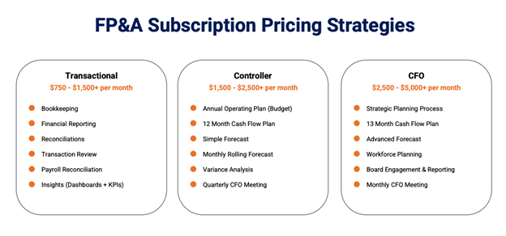Financial Planning and Analysis (FP&A) services go beyond traditional accounting functions, offering businesses strategic financial insights and data-driven suggestions. In the dynamic landscape of financial services, pricing, and packaging, all play a pivotal role in shaping the success of expanding your offerings.
Firms need to align their pricing and packaging strategies with the specific needs and value delivered to clients. By effectively pricing and packaging their services, firms can maximize their value proposition, enhance client satisfaction, and achieve long-term profitability.
The right pricing and packaging strategies ensure that clients receive the appropriate level of service while the firm can efficiently deliver and sustainably grow its offerings.
Hourly Billing
Hourly billing is a traditional method commonly used by professional service providers, including accounting firms. While it offers certain advantages, such as flexibility and transparency in tracking billable hours, it also comes with several challenges.
One significant challenge is the difficulty in budgeting and predicting project costs accurately. Since hourly rates can vary depending on the complexity and expertise required, it becomes challenging to estimate the final cost of a project upfront.
Plus, clients often expect both speed and quality of service, which can pressure firms to balance efficiency with delivering high-quality results. So the client doesn’t know how much they will pay each month, and the firm doesn’t know how much time to devote to the client.
Additionally, there is a concern over scope creep, where projects may expand beyond the initial agreement, leading to billing disputes and strained client relationships. As the business landscape evolves, firms are exploring alternative billing models to address these challenges and better align their pricing structures with the value delivered to clients.
Subscription Pricing
Subscription pricing is a popular modern billing model with a ton of benefits. One of its significant advantages is that it makes budgeting and predicting costs much more manageable than hourly billing or one-time fees. With subscription pricing, clients pay a fixed monthly or annual fee for a defined set of services or product bundles.
It's a predictive and stable revenue stream that allows businesses to plan their finances more effectively and allocate resources efficiently. The subscription model enables firms to streamline service delivery. Once clients are on a subscription plan, the firm can efficiently provide the predefined services without continuous negotiations or tracking billable hours.
The clients and the firm know precisely what they receive as part of their subscription. This transparency helps manage client expectations and reduces the likelihood of scope creep or billing disputes. Plus, it allows the firm to allocate resources efficiently, optimizing staff workload and capacity.
The monthly annuity from recurring subscriptions contributes to building enterprise value over time, as the consistent revenue stream enhances the firm's financial stability and overall attractiveness to potential investors or acquirers. As the number of subscribers grows, so does the firm's revenue and potential for growth. The scalable nature of subscription-based pricing allows firms to expand their client base without significant incremental costs.
Bundle Your Services
By bundling FP&A services, accounting firms can provide greater clarity in service offerings, presenting clients with well-defined packages that outline the specific services and deliverables they will receive. This clarity enables clients to better understand what they are getting and ensures transparency in the value delivered, increasing satisfaction, and reducing misunderstandings.
Bundling also allows firms to offer tailored solutions to client's unique needs and preferences. This customization ensures clients can choose the package that best aligns with their business objectives and financial goals, allowing for a more personalized and valuable experience.

Pricing Strategies
Implementing subscription pricing strategies involves careful consideration and strategic planning. It is helpful to create tiered subscription packages that offer different levels of services based on the complexity and needs of the client's business.
Each tier should have a price range encompassing variations in services, features, and benefits. This also allows firms to cater to diverse clients, from small businesses with basic requirements to larger enterprises with more complex financial management needs. By offering a range within each tier, firms can provide clients with options that align with their circumstances and budgetary considerations.
This approach ensures clients can choose the subscription package that best suits their requirements while enabling accounting firms to capture a broader market and maximize revenue potential. By offering a well-calibrated range of subscription tiers, accounting firms can effectively implement a subscription pricing strategy that benefits the firm and its diverse client base.

Build Relationships and Business
Developing well-defined subscription packages and establishing appropriate pricing structures is a strategic approach that can significantly benefit accounting firms and their clients. An ongoing engagement can lead to increased client retention and loyalty.
In addition, clients may be more likely to renew their subscriptions due to the continuous value they receive from the firm's services. Once clients are on board with a subscription package, accounting firms can leverage the ongoing relationship to upsell additional services or cross-sell complementary offerings. This practice not only increases revenue but also strengthens the client-firm partnership.
For your firm, pricing and packaging FP&A services fosters efficiency, predictability, and long-term value, ultimately contributing to the firm's growth, financial stability, and competitive positioning in the market.
The subscription-based model provides a buffer against market fluctuations and economic uncertainties. It helps mitigate risks and provides stability in challenging times. The convenience and transparency of subscription packages can attract new clients seeking straightforward pricing structures and comprehensive service offerings, providing a competitive advantage.
By aligning the value delivered to clients with their subscription packages, accounting firms can build strong client relationships, achieve sustainable revenue growth, and position themselves as leaders in the industry.
.png?width=150&height=63&name=TWRlogo-regmark_blueblack%20(1).png)
.png)










Do you have questions about this article? Email us and let us know > info@woodard.com
Comments: